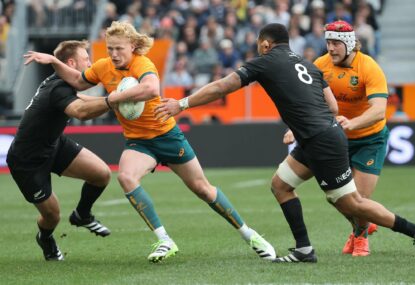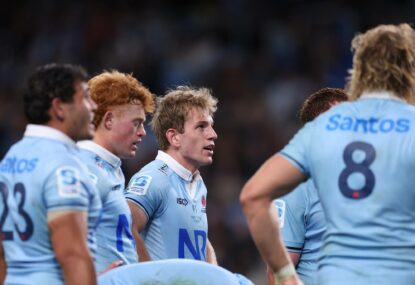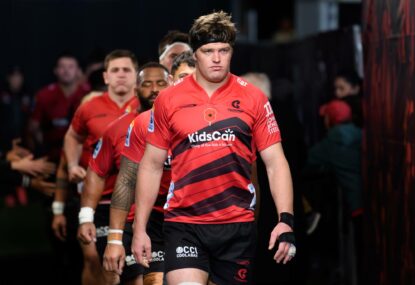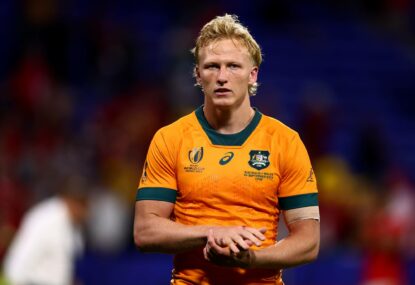Who will play fly-half for the Wallabies is one dilemma Ewen McKenzie will have to solve come selecting his first XV for the first Test against France on June 7.
The news that Quade Cooper will miss the rest of the Super Rugby season, the June Tests against France and at least half of the Rugby Championship does lessen his dilemma.
Cooper’s absence opens the doors for players such as Brumbies duo Christian Lealiifano and Matt Toomua and the Waratahs’ Bernard Foley to stake a claim on the now vacant No. 10 jersey.
>> Full Wallabies squad, positions and news
But if the Wallabies have dilemmas whether at fly-half, scrum-half or among the forwards, it does not compare with the curious case of France’s fly-half conundrum.
When the 31-man French squad was released for the three Test series against the Wallabies a few weeks ago, all eyes veered towards the list of fly-halves that head coach Philippe Saint Andre had selected for the trip Down Under.
The fly halves selected were Frédéric Michalak of Toulon and Remi Tales of Castres, with many surprised that Montpelier’s François Trinh-Duc was not on the list.
The stand-off has been the in-form French fly-half, with his excellent displays propelling Montpelier to second place in the Top 14 regular season. Though they narrowly lost to Castres in the semi-finals, his assured and creative tactical kicking display impressed media pundits.
If you watched the 2013 Six Nations you would have seen how bereft Michalak was. He looked devoid of creativity and at times resembled a man with no ability to create dangerous attacks whatsoever. He wasn’t even selected for this year’s Six Nations with Saint Andre preferring Stade Francais’ Jules Plission and Remi Tales. Trinh Duc was called up when Tales was injured for most of the competition.
But since the days of Marc Lievremont choosing a fly-half, let alone a halfback pairing, on a consistent basis is something that has been a rare occurrence within the French national team.
It does look like Saint Andre will start Remi Tales, who is a veteran of the Top 14, but lacks that international experience. He has performed well for Castres and led them to the Top 14 final, so his inclusion in the squad does have merit. But Michalak’s does not, especially with his lack of playing time this season.
Moreover, it could be that Saint Andre might employ one of his scrum-halves at fly-half in the form of Clermont Auvergne’s Morgan Parra. The ‘Little General’ has played at No. 10 for France before but doing so would be a waste of his talents.
France missed Parra greatly in the Six Nations in regards to his marshalling of the forwards, but also in terms of his goal kicking. The wayward kicking of Jean-Marc Doussain helped Ireland seal the Six Nations and the pinpoint accuracy of Parra’s boot will be a boon to the French – something the Wallabies should watch out for.
Within the 31-man squad, the return of skipper Thierry Dusautoir is a much needed tonic. His likely tussle with Michael Hooper will be one for the book. In addition, France will look to Dusautoir’s partner in crime at Toulouse, Louis Picamoles, to rampage past the gain line with his powerful ball carrying.
Among the three-quarter line there is emerging talent in the form of Castres’ full back Brice Dulin (a free running 15 in the mould of Willie le Roux when given space), Toulouse centre Gael Fickou (the future within France’s centres), Stade Francais winger Hugo Bonneval (son of well known French international Eric Bonneval) and uncapped Remi Lamerat of Castres.
Mixed with the upcoming players are veterans such as Toulouse winger Maxime Medard, Toulon’s hulk of a centre Mathieu Bastareaud, Toulouse winger Yoann Huget and Clermont’s world class Wesley Fofana, who will no doubt give Australia all sorts of trouble.
If Bastareaud represent unstoppable power, then Fofana represents silky creativity and poise that can cause many line breaks as he has done in his career.
Though France do have talent in their backs, in the past 10 years they have lost the flair that made them so feared in the 1970s, ’80s and ’90s. From Bernard Laporte and Marc Lievremont to Phillipe Saint Andre, the French press have accused them of betraying the values of French rugby that made rugby so great. The France of old were truly a sight to fear and that’s regardless of their combative forwards, notably those of Bordeaux Begles.
The backs of France were a combination of poise, strength, creativity and ruthless precision.
Players such as Serge Blanco, Philippe Sella, Christophe Lamaison, Pierre Berbizier and even Saint Andre helped score France some memorable tries. Many in France wish for the days when France openly attacked brazenly from their own 22 and regularly scored wonderful tries.
Nowadays the Top 14, France’s top domestic league, is more forward dominated, structured and rigid. The playing style in France’s leagues filters up to the international scene, and though it might be seen as pragmatic has recently added to the chaotic chance within French rugby.
What is needed is stability and consistent selection. It’s hard to play rugby when you suffer from changing your halfbacks every game.
It’s likely that whoever wins the physical battle among the breakdown will win the series. But while Australia are seeing light after the darkness of the Deans era, the French are plodding through the mud and stagnancy of the Saint Andre regime.
The three-Test series between the two sides will definitely be an intriguing contest.



































































































